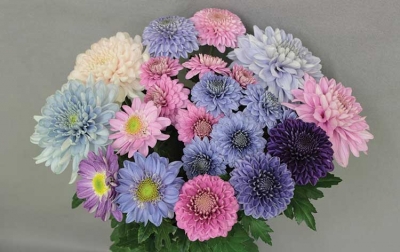
Now, after 13 years Japanese scientists have created a genuinely blue chrysanthemum. This could be applied to other species and could mean that florists will no longer have to dye flowers.
True blue requires complex chemistry. Anthocyanins – pigment molecules in the petals, stem and fruit – consist of rings that cause a flower to turn red, purple or blue depending on what sugars or groups of atoms are attached.
Naonobu Noda, a plant biologist at the National Agriculture and Food Research Organization in Tsukuba, Japan, first put a gene from a bluish flower called The Canterbury bell into a chrysanthemum. The gene’s protein modified the chrysanthemum’s anthocyanin to make the bloom purple. A second gene from the blue-flowering butterfly pea was then added. This gene’s protein added a sugar molecule to the anthrocyanin which turned the flowers blue. The two-step method was unexpected as the scientists believed multiple genes were required in a more complicated process. Chemical analyses showed that the blue colour came about in just two steps because the chrysanthemums already had a colourless component that interacted with the modified anthocyanin to create the blue colour.
True blue flowers are rare in nature, occurring only in select species like morning glories and delphiniums. According to the Royal Horticultural Society’s colour scale, most “blues” are really violet or purple.
Picture Credit : Google

